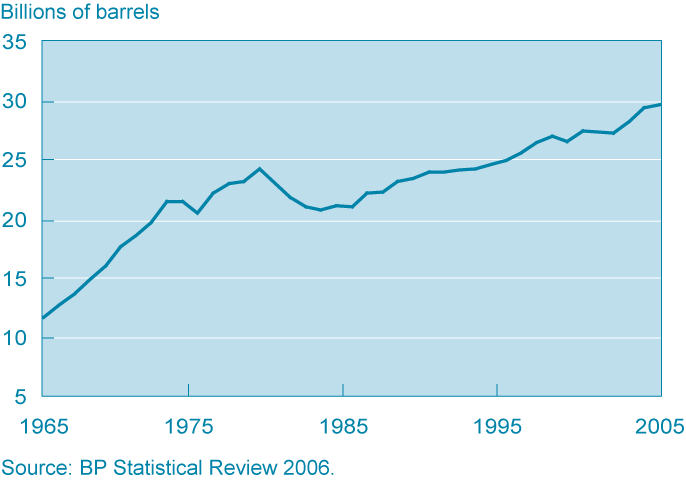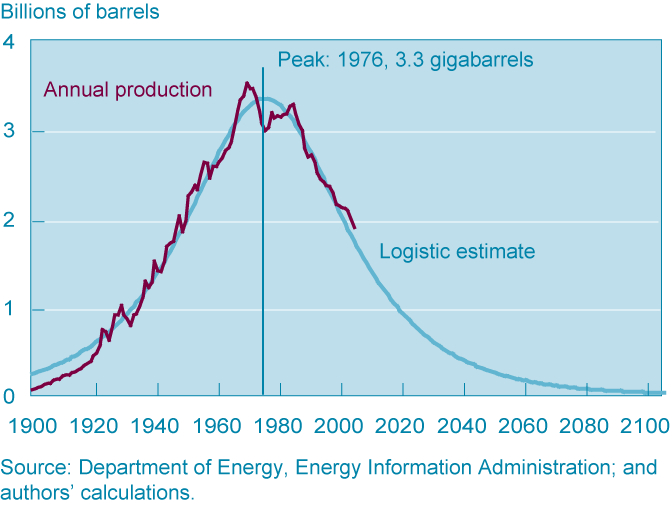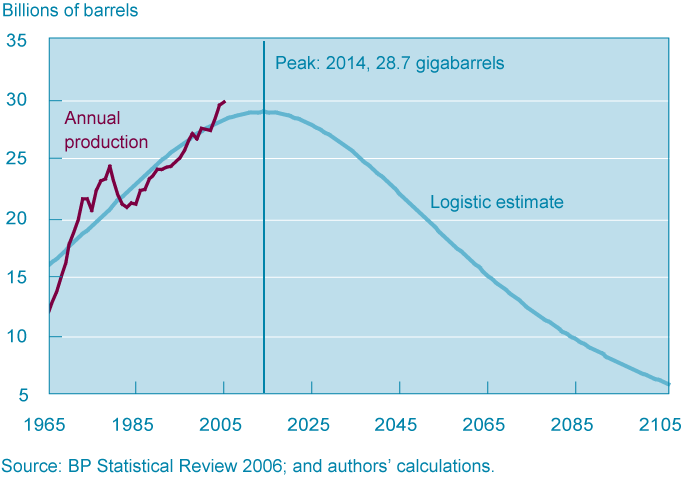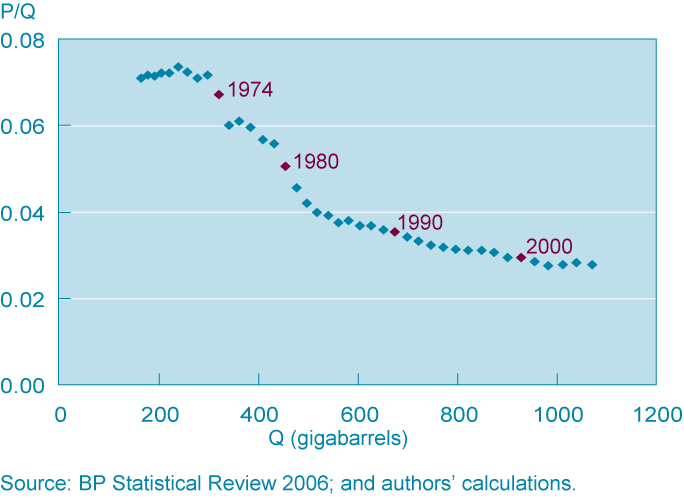- Share
Peak Oil
When will the world’s production of oil peak, and what will the economic consequences be?
The views authors express in Economic Commentary are theirs and not necessarily those of the Federal Reserve Bank of Cleveland or the Board of Governors of the Federal Reserve System. The series editor is Tasia Hane. This paper and its data are subject to revision; please visit clevelandfed.org for updates.
When will the world’s production of oil peak, and what will the economic consequences be? Calculating when turns out not to be so straightforward as it seems, but predicting the likely economic consequences is—and they’re not as bleak as many fear.
Is the world running out of oil? Though almost no one expects the black stuff to literally stop coming out of the ground anytime soon, some suggest that oil production, having trended upwards for the past century, will soon reach a year of maximum production—a peak—and then decline. The notion of a peak denotes a discernable change in the trend; as an alternative, some people argue a “plateau” of roughly constant production is more likely instead. In either case, given a finite amount of oil, production must decline sometime, and the question then becomes: When will world oil production peak, and what will be the economic consequences?
Most discussions of peak oil trace the concept back to the work of the geologist M. King Hubbert, who in the 1950s correctly predicted a peak in U.S. oil production between the mid 1960s and early 1970s. Later, in a 1976 National Geographic article, Hubbert predicted a world oil peak for 1995, and though this did not come about, the notion that oil production would soon peak and start declining is now often referred to “Hubbert’s peak.”
This approach to the problem of how much oil is available should not be confused with another popular approach, that of looking at proven oil reserves. Most people don’t readily grasp exactly whether say, 500 gigabarrels is a little or a lot, so reserves are usually expressed in terms of how long they would last at current rates of usage. For example, the Financial Times ran the headline “World still has 40 years of oil, says BP.” (June 13, 2007.) This approach to determining our remaining supply of oil becomes obviously flawed when the actual numbers are examined: in 1950, years of supply stood at 22. In 1972, the supply was of course not zero, and it had increased to 35 years; now in 2007, reserves stand at 40 years. (BP Statistical Review, 2007.) The problem comes in thinking of these proven reserves as a measure of the oil left in the earth. Rather, as one expert puts it: “reserves are defined as the known amounts of a mineral that can be profitably produced at current prices using current technology.” (Fisher, 1981, p. 94) As exploration continues, technology advances, and prices increase, more oil becomes available. Economically, reserves are more akin to a store’s inventory than to some ultimate measure of resource availability. While most people think of reserves increasing with new discoveries and decreasing as oil is pumped out of the ground, reserves also increase when new techniques make it cheaper to pump more oil and decrease when the price of oil falls. So, for example, fuel-efficient hybrid cars might decrease oil reserves because they decrease the demand for oil, driving down the price, making some oil reserves no longer economically feasible.
Trends
Peak oil analysis looks not at reserves but at production (extraction), the yearly flow rather than the stock. The problem of reckoning future supply then becomes discerning the trend in production. A look at total world production of crude oil (figure 1) does not show any obvious signs of decreasing production. Since 1965, world production has increased at an average of 2.4 percent per year. Indeed, fitting a simple trend and extrapolating from the past suggests that production will keep on increasing. Clearly, barring extraterrestrial sources, this increase can’t go on forever, but what evidence is there that it might stop anytime soon? Those expecting an imminent peak in oil production employ a different type of trend line, a nonlinear sort.

Suppose instead of drawing a straight line through the production data we draw a curve, such as a logistic. Why would we want to do this? For one, this pattern has appeared before. Oil production in the United States, shown in figure 2, did follow a nonlinear trend, increasing, flattening out, and then decreasing. A logistic trend, also drawn in figure 2, fits this pattern well for the U.S., so there is some reason to think that total world production may follow such a trend. Figure 3 shows what a logistic trend could look like for world oil production. Using statistical methods to choose the logistic curve that best fits the oil data yields 2014 as the year of peak oil production.

Another reason for considering a logistic curve follows from a rather subtle pattern in the data. Plotting yearly oil production (P) as a fraction of cumulative oil production (Q) against cumulative oil production, as in figure 4, shows a declining trend. More importantly, after about 1980, that trendbecomes linear, showing a roughly constant rate of decline in production as a fraction of cumulative production. In fractions, this linear trend translates to a logistic trend in production levels (Deffeyes 2005 provides some intuition for this mathematical fact, or for the hard stuff, check your favorite differential equations textbook).

In fact, this provides another approach to estimating the year of peak oil: fit the linear trend, and translate that into a logistic curve for production. The answer this method yields depends a bit on when you start the series, but our calculations show a peak in oil production in 2007. The two different approaches give two different answers (2014 and 2007), but the range of uncertainty is even larger, because these are statistical estimates, subject to error. One advantage of statistical techniques, however, is that they give us estimates of how big the errors are expected to be, and thus give some notion of how confident we should be in the predictions. In fact, it’s a useful exercise to look at the estimation error of the coefficients and see what bounds those put on peak oil.
For the nonlinear logistic case (2014), the 95 percent confidence bounds are 1989 and 2040. For the linear case (2007), the estimates put peak oil between 2004 and 2010. Looking at both estimates together puts peak oil somewhere in a 50-year band (though, obviously, 1989 was not a peak), again suggesting that dating the peak in oil production is an imprecise exercise.
Does Peak Oil Mean $200 a Barrel?
To some people, the notion of peak oil sounds scary. What will the future bring as the world moves from a century of increasing oil production to a period of decline? Despite the dramatic appeal of Road Warrior scenarios, with barbarians clashing over the few remaining oil wells, reality should prove to be much more prosaic. The first point to realize is that the peak represents the point of maximum production, not the date that oil runs out. Furthermore, the logistic curves all show a relatively flat peak, with a pronounced “hang time” near the peak. Production along the curve in figure 3 shows a much smoother decline than in some recent episodes. In the first oil crisis, world production dropped from 21.4 billion barrels (bbls) in 1974 to 20.4 bbls in 1975. In the base peak oil scenario, it takes 10 years—from 2014 to 2024—for a drop of that magnitude (0.7 bbls) to take place. A larger decline from 24.1 to 20.7 bbls took place from 1979 to 1983, but production (in our model) doesn’t drop off 3.4 bbls until 2034, 20 years after the peak.

Of course, there are more uncertainties associated with these numbers than just those that arise from estimation error. The trend between annual production as a fraction of total production and cumulative production (P/Q and Q) changed between the 1960s and the 1980s, and quite possibly could change again. Estimates for P and Q are not certain, and for strategic reasons not all countries freely share their oil data. Furthermore, market disruptions such as OPEC cartels and technology changes or major new discoveries may shift demand and supply enough to dramatically change the peak in oil production.
Pumping Economically
The concept of peak oil originated with petroleum geologists and engineers, but oil production is not exclusively determined by geology: it results from the equilibrium of demand and supply. There are economic reasons that suggest that a “peak oil” scenario might be plausible, but these reasons also considerably lessen the scare factor in such a scenario.
The standard economic story argues that production takes place until price equals the marginal production cost—that is, the point at which the cost of producing one more unit is just offset by the price for which you can sell that unit. Just like any other good, higher prices will call forth more oil (drilling in colder areas, moving further out on the continental shelf, and so forth) and also reduce demand, as people substitute away from oil by driving less, turning down the heat, and buying a solar heater for their pool. In the case of oil, it’s a little trickier because there is an added cost—pumping oil today means you can’t use that oil tomorrow. This adds what economists call an “opportunity cost” or a “rent” to the marginal cost. Oilmen would often call it a premium or royalty. In either case, it means the price of oil is often quite higher than the cost of pumping it out of the ground—which is exactly as it should be because it is a resource in fixed supply.
Finding the best pattern of oil production thus comes down to specifying the path of the royalty over time. This should make sense because the net social gain from pumping oil today is the price less the production cost, that is, the royalty. Consider the choice between pumping the oil now or next year. If we are depleting oil at the optimal rate, we should be indifferent between the choices. For example, if oil is more valuable in the future, we should forego pumping it today and leave it in the ground for next year, when it is worth more. When will we be indifferent about when we pump? The first guess would be when the royalty is equal in both periods. This is not quite right, because of the time value of money—a dollar today is not the same as a dollar next year, because you can put the dollar today in a bank, earn interest, and get more than a dollar tomorrow. Thus, tomorrow’s royalty should be larger than today’s by the rate of interest. Roughly speaking, you have two choices—pump the oil today and sell it, putting the money in the bank, or pump the oil next year, and sell it then. The payoff should be the same.
In the simplest case of applying this logic, with a known, fixed supply of oil and with zero extraction costs, we get what economists call Hotelling’s rule: the price should rise at the rate of interest. With a fixed supply of oil, this means that in each period, less and less oil is produced (thus increasing the price). In this case, optimal oil depletion looks like the down side of the Hubbert curve. That has a lesson: With a known, finite amount of a resource, gradually extracting less over time is the best thing to do, balancing off current returns against future benefits. The gradually increasing price serves to conserve oil and also provides incentives for increased exploration and production.
Would peak oil ever look optimal? The analysis so far has ignored exploration. In fact, the world did not start out with a “known, fixed supply of oil.” At one time no one knew there was oil in Texas, much less the Middle East, and Cleveland was the oil capital of the world!
With exploration, the price of oil initially drops as the large oil fields get discovered and world supply increases. Eventually, it becomes harder and harder to find more oil (think drilling further and further out into the continental shelf), and the increasing royalty drives the price up. This pattern of a falling then rising price is reflected in the quantity produced, which increases and then decreases—the pattern predicted by peak oil. Rather than indicating a failure or flaw in the oil market, though, it represents the solution to the problem of balancing demand, production costs, and the value of conserving oil for the future.
Uncertain, Not Necessarily Gloomy Future
Peak oil suggests that, while we’ve enjoyed expanding production so far, some day in the future (near or not so near) production will peak and begin to wane. Future production of oil is uncertain, but the uncertainty is not only about the amount of oil in the ground but also the costs and benefits of pumping it. Oil is one source of energy, but economics teaches us that there are substitutes. A high enough price for oil will call forth increased exploration, but also exploration of alternative sources, such as tar sands and oil shale, that are not worth exploiting when oil prices are lower.
In fact, one of the earliest uses for oil was to produce kerosene, a cheaper substitute for whale oil, though the electric light eventually made that petroleum product less vital. Thus there is substitution in the uses of oil as well as the sources. It’s the interplay between these costs and alternatives that presents the true lesson of peak oil, though understanding the limits to growing trends represents an important first step.
Recommended Reading
- BP Statistical Review of World Energy. June 2007. <www.bp.com/statisticalreview>.
- Kenneth S. Deffeyes. 2005. Beyond Oil: The View from Hubbert’s Peak, Farrar, Straus, and Giroux.
- Anthony C. Fisher. 1981. Resource and Environmental Economics, Cambridge surveys of Economic Literature, New York: Cambridge University Press.
- Joseph G. Haubrich, Patrick Higgins, and Janet Miller. 2004. “Oil Prices: Backward to the Future?” Federal Reserve Bank of Cleveland, Economic Commentary (December).
- M.King Hubbert. 1956. “Nuclear Energy and the Fossil Fuels,” Presented before the spring meeting of the Southern District, American Petroleum Institute, Plaza Hotel, San Antonio, Texas, March 7-8-9.
- In case you were wondering, Haubrich’s favorite differential equations book is: George F. Simmons. 1972. Differential Equations with Applications and Historical Notes, New York: McGraw-Hill.
This work by Federal Reserve Bank of Cleveland is licensed under Creative Commons Attribution-NonCommercial 4.0 International





